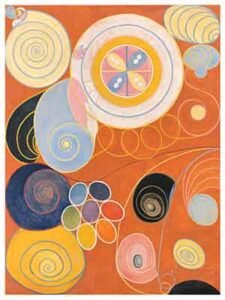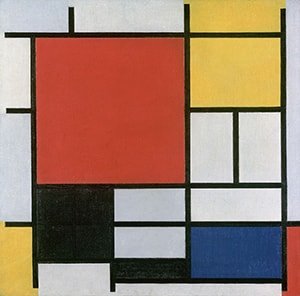This post is also available in: Español (Spanish)
Emergence of abstraction.
The biggest change in non-figurative art was the elimination of the reference to the world of identifiable objects. At the beginning of the twentieth century, abstract art was a revolutionary concept, in which identifiable people and objects were set aside, floating shapes similar to beings and geometric things began to appear, large areas of color covering the entire canvas and horizontal and vertical lines.
The deepest change was to eliminate the reference to the world of identifiable objects. The art without representation.
The Impressionists had reduced the domain of realism over the physical world and sometimes were near to abstraction.
The notion of abstraction was not entirely new, it is the case of the painter J. William Turner whose swirls of colors are identifiable with ships in the sea. The Cubists divided the objects into multiple planes, not intended to abolish the representation, but only to reform it in its spatial dimensions.
The Expressionists and Fauvists represented nature by separating themselves from the colors they usually used. The artists’ paintings had not yet abandoned concrete reality and did not dispense with figures and objects.
Pioneers of abstract art.

When referring to the pioneers of abstract art, we must mention Hilma af Klint, of Swedish origin (1862-1944). She creates her works before the presentation of Kandinsky’s works in 1911, who is historically said the creator of abstract art. This situation is due to the fact that the works of Hilma af Klint were not released until 1986. This was partly due to her own decision and partly influenced by Rudeel Stanley, president of the anthroposophy society (deals with the search of the hidden wisdom and the spirits), to which she adhered, who suggested that these works not be disclosed at that time, since they would not be recognized or accepted.
Hilma af Klint studied at the Royal Academy of Art in Stockholm because they accepted women there, which was not usual at that time. She transmitted the spiritual issues through art, was a portraitist and landscape artist, but her main work was the abstract one, in which she embodied a supra earthly world, far from visual appearances in order to reach a knowledge beyond the material.
In 1892 she formed the group of The Five, who aim to capture astral knowledge in art.
Making automatic paintings and collective drawings in the séances. Her extrasensory experiences guided her in the creation, investigating the line, the color, the symbols, the word, the atoms, the matter and the energy. She was interested in duality, good and evil, woman and man, religion and science. She deployed in her works concentric circles, ovals, spirals, pyramids and triangles (symbol of the spiritual development of man).
She left a prolific work, whose merit was to create for the future, leaving us a vision of life away from material.
Some historians define abstraction as the natural result of a formal representation process that inherits the teachings of Cubism with Kasimir Malevich and Mondrian as the pioneers of that process. Others point out that abstract art is the consequence of a spiritual search with deep roots in Expressionism with Kandinsky’s case. His work evolved into abstraction based on colorful Expressionism.
The Blue Rider was the name imposed on a group of German Expressionists in 1911. Its most important representatives are: Vassily Kandinsky and Franz Marc. Kandinsky and his group thought that healing could be done through art, and achieve a new art, spiritual and transcendent. Kandinsky expressed that the spirit of modern man was oppressed by materialism. In this situation, man must find a new spiritual sense. Painting and arts are in a return to spiritual, and an approach to it is to reach abstraction, to the elementary.
For Kandinsky (Moscow 1866-1944) the composition of chromatic forms and drawings, arise from an inner imperative, and express an intimate vision of the human soul. His abandonment of figuration is due to the need to find another way to project his visualizations that overcome the apparent contradiction between form and color. The artists must be creators of their own and personal work, and must express it according to the conditions of their time (the temporal), and reflect the content of art from all ages, (the eternal), which responds to mystical needs. Each form has an inner content for them, and is the outer manifestation of that content. The harmony of the forms must be based on an inner need. According to Kandinsky, painting is an art, and art, in its global aspect, is not a useless creation of objects that fall apart in the emptiness, but a useful force that serves the development and awareness of the human soul.
Kandinsky joined the Bauhaus school in 1922. In his book Point and Line On the Plane, he intended to lay the foundations for a scientific theory of art. He an

alyzes the point, the line and the plane, convinced that the forms are variations on a single theme that presents infinite possibilities, by the action of opposites, similarities, etc. His work is the result of a meticulous composition, which requires outlines and diagrams. Kandinsky studied the psychological influence of color and the emotional power of music. He considered that the colors had a deep expressive force and possessed their own qualities. Example: the vermilion expresses a spiritual vibration, like a flame.
In turn, Malevich and Mondrian reach abstraction through a process linked to Cubism, in which spatial dimensions are challenged. For Malevich (Moscow 1878-1935), according to his statements, he achieves an art in which the ability to create a construction does not derive from the relations between form and color, nor in the aesthetic gesture, but is built on the basis of weight, speed and direction of the movement, thus reflecting the supremacy of pure feeling, or the sensation in the pictorial arts, which he called Suprematism.
The object has no meaning for R. Malevich, he sought non-objective representation. We observe him in his series of paintings White on White, or Dynamic Suprematism. There, the geometric shapes are abstract. He tries to express deep feelings and expressions of personality.
Piet Mondrian’s research (Netherlands 1872-1944), propose as a dogma the structuring of the support plane with vertical and horizontal lines, which determine a set of planes painted with pure colors: white, black and gray. His desire was to achieve personal purity and divine simplicity. He used the primary colors, in addition to black and white. His style was austerity. His work: “Diamond painting in red, yellow and blue” is a dynamic work with a great balance.
The pioneers Kandinsky, Malevich and Mondrian achieved their style in different ways, but all of them aimed to combat the limitations of socially dominant materialistic values, with a series of new and deep values. Their creative approach was steeped in Eastern esoteric beliefs, ancient philosophy and recent mystical literature. They wanted their art could offer the foundation of an orderly and spiritual life.
What is abstract painting?
How we define abstract painting if we do not emphasize its formal structure. According to G. Deleuze and F. Guattari, it is a construction that does not have a direct reference to the outside world, with planes of uniform colors, or lines that change, without interior or exterior, without shape or background, and geometric figures or continuous lines. All of them are manifestations of the forces that the artist sets in motion when creating.
Without identifiable persons and objects, it is art without representation of the object.
Abstraction in art allows to achieve an expression of the artist in total freedom, so he can fully manifest his/her inner world.
Abstract painting allows a release of the shapes of objects as they are. That way it is achieved deep intimate expression with feelings and emotions. What is painted or drawn is not reality but what everyone perceives, imagines or feels what it is. The inner world of the artist is manifested, expressed. The variations are multiple, as artists have expressed throughout history. The pure stain, geometric shape, color planes. Therefore, the expression abstract painting is more comprehensive in the pictorial plane than its term indicates. That is why abstract art has been divided into two large fields: geometric and lyrical. However, the important accent of abstraction is not the formal part of the work, but the way in which the artist transmits his/her forces and makes them visible through chaos, sublimation, clean, clear, flat spaces, color planes or geometric figures.

.png)
Very beautiful